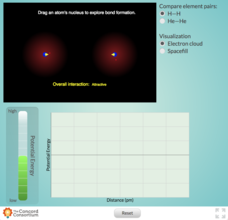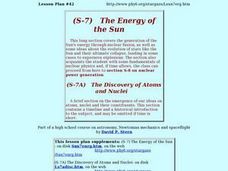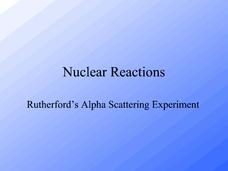PHET
Alpha Decay
There are different types of radioactive decay, and alpha decay is when there are too many protons in a nucleus. Here is a simulation that shows alpha particles being emitted from a polonium nucleus. Learners see how radioactive decay...
Curated OER
Boy or Girl?
In this science worksheet, students determine which nuclei is from a boy and which one is from a girl. Students are given six steps to help in determining the difference.
Curated OER
Making Clouds
In collaborative groups, mini-meteorologists investigate the conditions that must be present for clouds to form: cooling air, water vapor, and condensation nuclei. In addition to procedures, a chart for observations and some follow-up...
Curated OER
Prokaryotes and Eukaryotes
Examine cyanobacteria cells as an example of prokaryotes and several other alga as examples of eukaryotes. Future biologists compare the two and notice the absence of nuclei in prokaryotes. These are classic activities for this purpose,...
Concord Consortium
Non-Bonding
What makes helium so Noble, anyway? Explore the bonding properties of helium versus those of hydrogen using an interactive resource. Science scholars manipulate atoms of each element and observe changes in potential energy as the atoms...
Curated OER
Cell Structures and Their Functions
Life science learners investigate live cells. They examine wet mount slides of cyanobacteria and Elodea plants. They peer into the dynamic microscopic world of protists. Afterward, they construct a model of a cell, including rudimentary...
Curated OER
Properties of Matter
Ninth graders explore the molecular structure of matter and how it can affect the physical characteristics of a specific material. They demonstrate that isotopes of an element have different masses. Students demonstrate that the rates of...
Curated OER
The Radium Girls
In this radium worksheet, 7th graders determine the substance used to make the dials of watches glow in the early 1900's. Then they explain why radium glows and what the three most common types of emissions from radioactive nuclei and...
Curated OER
Cloud In a Bottle
For this cloud worksheet, students use a clear plastic bottle to simulate the process of cloud formation. They drop a lit match into the bottle that contains water and shake it to form condensed water or clouds. They answer questions...
Curated OER
Edible Atom/Molecule
Upcoming chemists construct atom or molecule models out of candy. This is a classic idea that learners really enjoy; however, this lesson plan is vague. There is no instruction about the structure of atoms or molecules. Make sure you...
Curated OER
The Energy of the Sun
Students study energy generation by the Sun, which involves atoms and nuclei.
Curated OER
Radioactive Decay: A Sweet Simulation of a Half-life
Students demonstrate rates of decay of unstable nuclei can be measured. They understand ratios and multiplication of fractions. They simulate radioactive decay. They read about the accomplishments of scientists.
Curated OER
Fracture Fundamentals: A Cheesy Analog
Students make small cuts (fracture nuclei) in processed cheese food and then apply stresses perpendicular or parallel to the cuts to see how fractures grow. They make predictions before each experiment and explain their results to the...
Curated OER
Microviewer
In this microviewer worksheet, students observe several types of cells. Students draw each type of cell and label the important parts. Students also answer questions relatable to the cell and the purpose for study.
Curated OER
What is Weather II?
For this weather worksheet, students explain how temperature affects the humidity in weather. Then they complete a chart about the different types of clouds seen in the sky. Students also describe how clouds form and why.
Curated OER
Nervous Tissue
In this nervous tissue worksheet, students list and describe the functions of the nervous system and its two principle parts. Then they list and give the function and location of the six types of glial cells. Students also describe two...
Curated OER
Reproduction in Flowering Plants
Detailing the structures and functions of flowering plants, this slide show will help your students understand the processes and the conditions that allow pollination and fertilization. Labelled diagrams help introduce the reproductive...
Curated OER
The Four Groups of Biologically Important Compounds
This is not they typical set of teacher instructions. It is an organized chart of the important organic compounds. For each, the involved elements, the name of the building block monomers, the names of polymers, extra information, and a...
Curated OER
Nuclear Reactions - Rutherford's Alpha Scattering Experiment
Neat! Show your physics class exactly how Ernest Rutherford fired alpha particles at a piece of gold foil and so determined that most of an atom is composed of empty space. Not just a slide show, but almost an animation, this...
Curated OER
Size of Atoms - Trends
This compendious collection of slides leaves no questions when it comes to the concept of atomic size. Thorough and easy-to-read graphs, tables, and graphics explain atomic radii, the shielding effect, the octet rule, isoelectric...
Massachusetts Institute of Technology
Nuclear Synthesis
Start this lesson with a bang! The eighth in a 13-part series of lessons explains the origin of elements beginning with the Big Bang Theory. The reading describes the formation of elements hydrogen through uranium.
Curated OER
Atomic Structure
The first nine slides visit the history of our understanding of atoms. The next several outline the structure of atoms. Subatomic particles, electron configuration, and diagramming methods are introduced. This is a neatly organized...
Science Geek
Nuclear Chemistry
Which bichemicals wash up on shore? Nucleotides! Presentation covers alpha, beta, and gamma radiation. Includes a comparison of fission versus fusion. Presentation is the second in a five-part series.
Chapman University
The Standard Model Poster
Chemistry classes will appreciate this color-coded, single-page reference sheet for The Standard Model of particle physics. It is divided into two main sections: elementary particles and compound particles, both with their antiparticles....
Other popular searches
- Nucleic Acids
- Nucleic Acids Worksheet
- Condensation Nuclei
- Multiple Nuclei Model
- Atomic Nuclei
- Proteins and Nucleic Acids
- And Condensation Nuclei
- Carbo Lipids Nucleic Acids
- Nucleic Acid Groups
- Cloud Condensation Nuclei
- Nucleic Acids Dna Worksheet
- Nucleic Acid Structure

























